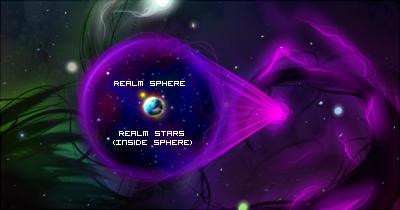Space, Stars, the Suns, and Moons
Said to be bound in starlight with enchanted pages, this book holds information about space, stars, the suns, and the moons of our Realm Spheres.

Space is a strange and complex combination of unbound energy and chaotic reiatsu, as well as vast expanses of unexplained and inexplicable ‘nothingness’ both near the Realms and outside of their borders. The Nothing upon which Void hydras and First Beings walk is not actually nothing, but it is a type of energy that cannot be controlled or manipulated by regular living beings, immortal or otherwise. Some scholars believe that not even the gods, split as they are, truly know what it is or how it came to be.

Realms are surrounded by a spherical globe of space that is enclosed within a shield of energy, generally invisible from within, called the Veil, which separates the Realm from the Nothing outside. The Markers within a Realm’s world give energy to the Veil, upon which the Void hydra grasps; without the Markers, the Veil would fail and evaporate, leaving the Realm to be destroyed by the Void’s chaotic energy.
The energy inside the Spheres differs between all Realms, and each is generally unique. At the center of each Realm Sphere, there is the world of that Realm itself - as well as its related suns and moons. The planet is known to be stationary within the Sphere, and the suns and moons (which are much smaller than the world at the center of the Realm) orbit around it.

Stars are divided into three distinct categories, depending on where they are located and what they are composed of. All stars are made of energy - usually reiatsu that is akin to the element of Light, though understood to not be the same. Star types are:
- Realm Stars are stars that are found within the Sphere; these stars do not leave the Realm Sphere unless the Veil is completely breached, and once in contact with the Nothing, they will dissipate.
- Void Stars are those that are found outside of the Spheres; they float alongside the great Void hydras, and may sometimes be seen from within the Spheres, though it depends on the thickness of the Veil and the energy within. They are much, much larger and much more powerful than Realm stars, and can easily overload any immortal or mortal who attempts to use them.
- Divine Stars are the last in this category, and are made by the gods in constellations, and cannot be manipulated by any mortal, immortal or lesser god as the other two types can. Realm Stars and Void Stars can give power to Cosmic and Celestial dragons, where Divine Stars cannot.
Scholars have just begun to discover that they may track the movements of other Void hydras through their Void Stars, as well as the Veil-shielded balls of light that are the Realm Spheres, though the latter may sometimes be hidden from view. On some Void hydras, the energy connecting the Realms to the hydra’s head or tail can be seen in bright flashes and flares of color, moreso if a hydra is younger.
Suns and Moons
Suns and moons are composed of reiatsu, where suns are bright and made of lightfire, and moons are made of solid, shimmering reiatsu somewhat akin to Soulgems in nature.
Moons in the Realms, being solidified reiatsu, do not naturally have traditional moon phases; phases are dictated by the gods of each Realm, and often have set patterns they follow per Realm, per moon. This effect is known as the 'god's breath', and very rarely may be altered by the gods of the cosmos to relay messages to the mortals below that they govern.
Each moon is an opaque orb of colored reiatsu; within is a hollow space filled with energy in constant motion. As the fastest energy moves just beneath the moon's glassy surface, it emits light that differs in brightness per moon and Realm. Often, the moons will be a bright, pale color, and white or silver is the most common. It should be noted that Kurai's moon is not actually a moon, but a corrupted sun, and therefore has no phases.

Phases often differ per Realm; this is a chart that shows the current moon phase schedule for each world.
